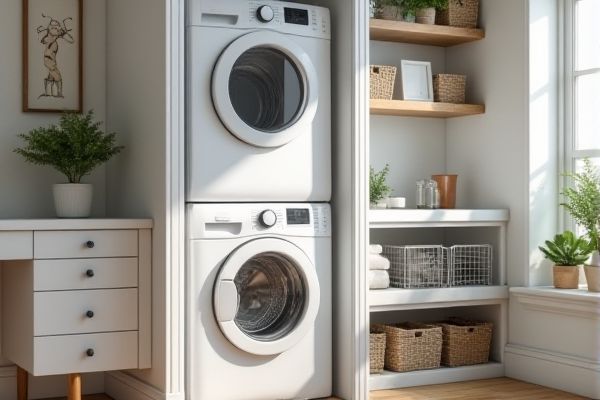
Stacked washer dryer units save valuable floor space by combining both appliances vertically, making them ideal for small laundry rooms or apartments, while side-by-side models offer greater flexibility and easier access to both machines simultaneously, often with larger capacities. Discover which setup best fits Your laundry needs and lifestyle by exploring the detailed comparison in the rest of this article.
Table of Comparison
| Feature | Stacked Washer Dryer | Side by Side Washer Dryer |
|---|---|---|
| Space Efficiency | Ideal for small spaces; vertical design saves floor space | Requires more floor space; wider footprint |
| Installation | Requires stacking kit and proper alignment | Simple installation; appliances side by side |
| Accessibility | Higher dryer placement; may be hard to reach | Both units at the same, easy reach |
| Capacity | Generally smaller dryer capacity | Typically larger capacities in both units |
| Maintenance | More challenging access for repairs | Easier to service individual units |
| Cost | Often more affordable combined unit | Potentially higher total cost for separate units |
| Flexibility | Limited to matched set | Mix and match brands and models |
Introduction to Stacked vs Side-by-Side Washer Dryers
Stacked washer dryers save valuable floor space by vertically aligning the washer and dryer, making them ideal for compact laundry rooms or apartments. Side-by-side units offer more flexible access to both machines simultaneously, enhancing convenience for multitasking during laundry cycles. Choosing between these configurations depends on your available space and how you prioritize accessibility versus footprint efficiency.
Space Efficiency Comparison
Stacked washer dryers maximize space efficiency by combining both units vertically, making them ideal for small apartments or tight laundry rooms where floor space is limited. Side-by-side models require more width, offering easier access to washer and dryer doors but consuming greater floor area. Choosing between the two depends on room dimensions, storage needs, and accessibility preferences, with stacked units winning in compact spaces and side-by-side units preferred in larger laundry areas.
Capacity Differences
Stacked washer dryer units typically offer smaller capacity compared to side-by-side models due to their vertical design constraints. Side-by-side washers and dryers generally provide larger drum sizes, accommodating bigger loads and reducing the frequency of laundry cycles. Consumers with larger families or heavy laundry demands often prefer side-by-side units for their enhanced capacity and efficiency.
Installation Requirements
Stacked washer dryer units require minimal floor space, making them ideal for small laundry areas or closets but often need specific venting and electrical setups that fit within vertical configurations. Side by side machines demand more floor area and may offer easier access to both appliances but typically require separate water, drainage, and power connections spaced apart. Your choice depends on available space and the feasibility of meeting plumbing and electrical installation requirements in your laundry room.
Ease of Use and Accessibility
Stacked washer dryers maximize vertical space, making them ideal for small laundry rooms but can challenge accessibility due to elevated controls and loading heights. Side by side units offer easier access to both washer and dryer doors at waist level, improving convenience and reducing strain during use. Your choice depends on whether you prioritize compact design or easier reach for frequent laundry tasks.
Maintenance and Repair Considerations
Stacked washer dryers often require more specialized maintenance due to their vertical configuration, which can make access to components like hoses, filters, and belts more challenging. Side-by-side units offer easier repair and routine maintenance since each machine can be accessed independently without dismantling the setup. Repair costs for stacked models may be higher due to complex disassembly, while side-by-side units typically have lower service expenses and more straightforward troubleshooting.
Cost Analysis: Stacked vs Side-by-Side
Stacked washer dryers typically offer a more cost-effective solution due to their compact design, often priced lower than side-by-side units both in initial purchase and installation expenses. Side-by-side models generally involve higher costs because of their larger footprint and the need for additional space, which can lead to increased remodeling or utility adjustments. Your choice depends on balancing budget constraints with space availability and convenience preferences.
Aesthetic and Design Options
Stacked washer dryer units offer a sleek, vertical design ideal for small spaces, maximizing floor area while maintaining a modern aesthetic. Side-by-side machines provide more surface space for folding and sorting laundry, with the flexibility of choosing different models or finishes to match your room decor. Your choice will impact the visual flow and functionality of your laundry area, balancing compact style with practical workspace.
Pros and Cons of Each Configuration
Stacked washer dryers save valuable floor space, making them ideal for small apartments or tight closets, though they may require bending or reaching for loading and unloading compared to side-by-side models. Side-by-side configurations offer easier access to both units simultaneously and larger loading capacities but demand more room, which may not be suitable for compact living areas. Energy efficiency and maintenance accessibility vary by model, with stacked units sometimes harder to service due to their vertical design.
Choosing the Best Washer Dryer Setup for Your Home
Stacked washer dryers save valuable floor space, making them ideal for small or compact laundry areas, while side-by-side setups provide easier access and separate units for simultaneous washing and drying. Your choice depends on your space constraints and laundry habits, with stacked units offering efficiency in tight quarters and side-by-side models delivering more flexibility and capacity. Consider your home's layout and daily laundry volume to select the setup that best complements your lifestyle and maximizes your convenience.
 homyna.com
homyna.com